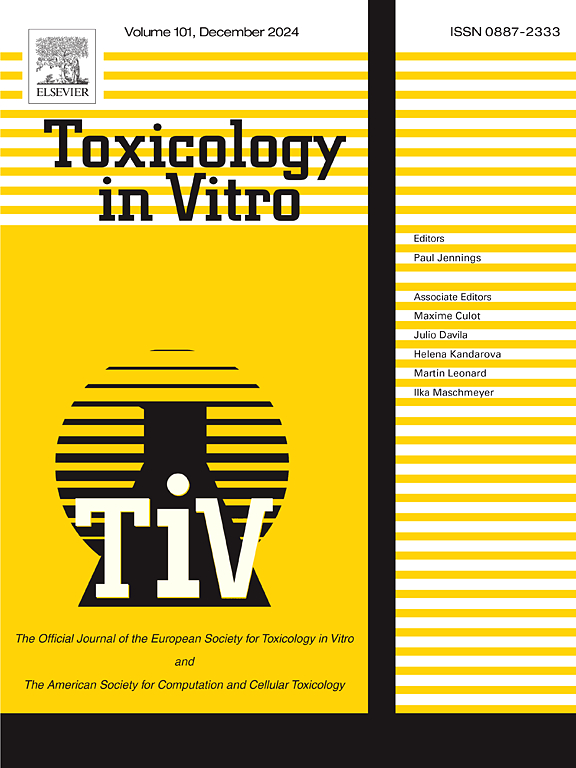The obesogenic effects of Bisphenol A and its analogues are differentially regulated via PPARγ transactivation in mouse 3T3-L1 cells
IF 2.6
3区 医学
Q3 TOXICOLOGY
引用次数: 0
Abstract
Exposure to environmental pollutants with obesogenic activity is being recognised as one of the contributing factors to the obesity epidemic. Bisphenol A (BPA) has been shown to stimulate adipogenesis in both human and mouse preadipocytes, to increase body weight and affect lipid metabolism in animal and epidemiological studies. Regulatory action and public concern has prompted industry to replace BPA with other structurally similar analogues that may have similar effects.
In this study we investigated the effects of fifteen BPA analogues on adipogenesis in the mouse 3 T3-L1 pre-adipocyte cell model in order to determine their adipogenic activity relative to BPA. 3 T3-L1 cells were treated with increasing concentrations of BPA and replacements and mRNA expression of the mature adipocyte markers fatty acid binding protein 4 (Fabp4), perilipin (Plin) lipoprotein lipase (Lpl)and peroxisome proliferator-activated receptor (Ppar)γ and lipid accumulation were assessed. In addition, a luciferase reporter assay for PPARγ transactivation was employed to investigate mechanism of action.
Our results show that BPC, BPS-MAE, BPS-MPE and TGSA, were the most adipogenic bisphenols, as shown by a robust increase in lipid accumulation and mRNA expression of adipogenic markers. BPS-MPE, BPC, BTUM, TGSA and D8 increased PPARγ transcriptional activity. Despite its ability to activate PPARγ in the transcriptional assay D8 did not affect adipogenesis in this cell model.
在小鼠3T3-L1细胞中,双酚A及其类似物的致肥作用通过PPARγ转激活受到差异调节。
暴露于具有致肥活性的环境污染物被认为是导致肥胖流行的因素之一。在动物和流行病学研究中,双酚A (BPA)已被证明可以刺激人和小鼠前脂肪细胞的脂肪生成,增加体重并影响脂质代谢。监管机构的行动和公众的关注促使工业界用其他结构相似、可能具有类似效果的类似物取代双酚a。在本研究中,我们研究了15种BPA类似物对小鼠3 T3-L1前脂肪细胞模型脂肪形成的影响,以确定它们相对于BPA的成脂活性。3 T3-L1细胞通过增加BPA浓度和替代品处理,并评估成熟脂肪细胞标志物脂肪酸结合蛋白4 (Fabp4)、脂磷脂(Plin)脂蛋白脂肪酶(Lpl)和过氧化物酶体增殖物激活受体(Ppar)γ mRNA表达和脂质积累。此外,采用荧光素酶报告实验对PPARγ的转激活进行了研究。我们的研究结果表明,BPC、BPS-MAE、BPS-MPE和TGSA是最具致脂性的双酚类物质,这可以通过脂质积累和致脂标志物mRNA表达的显著增加来证明。BPS-MPE、BPC、BTUM、TGSA和D8增加了PPARγ的转录活性。尽管在转录实验中,D8能够激活PPARγ,但在该细胞模型中,D8并不影响脂肪的形成。
本文章由计算机程序翻译,如有差异,请以英文原文为准。
求助全文
约1分钟内获得全文
求助全文
来源期刊

Toxicology in Vitro
医学-毒理学
CiteScore
6.50
自引率
3.10%
发文量
181
审稿时长
65 days
期刊介绍:
Toxicology in Vitro publishes original research papers and reviews on the application and use of in vitro systems for assessing or predicting the toxic effects of chemicals and elucidating their mechanisms of action. These in vitro techniques include utilizing cell or tissue cultures, isolated cells, tissue slices, subcellular fractions, transgenic cell cultures, and cells from transgenic organisms, as well as in silico modelling. The Journal will focus on investigations that involve the development and validation of new in vitro methods, e.g. for prediction of toxic effects based on traditional and in silico modelling; on the use of methods in high-throughput toxicology and pharmacology; elucidation of mechanisms of toxic action; the application of genomics, transcriptomics and proteomics in toxicology, as well as on comparative studies that characterise the relationship between in vitro and in vivo findings. The Journal strongly encourages the submission of manuscripts that focus on the development of in vitro methods, their practical applications and regulatory use (e.g. in the areas of food components cosmetics, pharmaceuticals, pesticides, and industrial chemicals). Toxicology in Vitro discourages papers that record reporting on toxicological effects from materials, such as plant extracts or herbal medicines, that have not been chemically characterized.
 求助内容:
求助内容: 应助结果提醒方式:
应助结果提醒方式:


